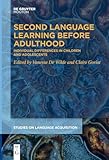Second Language Learning Before Adulthood : Individual Differences in Children and Adolescents / ed. by Vanessa De Wilde, Claire Goriot.
Material type: TextSeries: Studies on Language Acquisition [SOLA] ; 65Publisher: Berlin ; Boston : De Gruyter Mouton, [2022]Copyright date: ©2022Description: 1 online resource (VI, 264 p.)Content type:
TextSeries: Studies on Language Acquisition [SOLA] ; 65Publisher: Berlin ; Boston : De Gruyter Mouton, [2022]Copyright date: ©2022Description: 1 online resource (VI, 264 p.)Content type: - 9783110742947
- 9783110743135
- 9783110743043
- Children -- Language
- Second language acquisition
- Individuelle Differenzen
- Individuelle Unterschiede
- Junge Sprachlerner
- Sprachenlernen
- Sprachlernen
- Zweitsprache
- Zweitsprachlernen
- LANGUAGE ARTS & DISCIPLINES / Linguistics / General
- Individual Differences
- Second Language Learning
- Young Language Learners
- 418.0071 23
- P118.2 .S436 2022
- online - DeGruyter
- Issued also in print.
| Item type | Current library | Call number | URL | Status | Notes | Barcode | |
|---|---|---|---|---|---|---|---|
 eBook
eBook
|
Biblioteca "Angelicum" Pont. Univ. S.Tommaso d'Aquino Nuvola online | online - DeGruyter (Browse shelf(Opens below)) | Online access | Not for loan (Accesso limitato) | Accesso per gli utenti autorizzati / Access for authorized users | (dgr)9783110743043 |
Frontmatter -- Contents -- Introduction -- Learning disabilities as external individual differences in second language acquisition -- The role of memory in the acquisition of vocabulary and grammar in the first language and in English as a foreign language -- Individual differences and young learners’ L2 vocabulary development: The case of language aptitude and exposure to subtitled TV series -- ‘In love with English’: A mixed-methods investigation of Flemish children’s spontaneous engagement with out-of-school exposure -- The relation between out-of-school exposure to English and English vocabulary development in Dutch primary school pupils -- Lexical profiles of children and adolescent EFL learners in the semantic domain of animals -- The contribution of motivation and emotions to language learning autonomy in the Hungarian secondary school classroom: The results of a questionnaire study -- Effects of authentic communication experiences on linguistic self-confidence: Individual differences in perceptions among Japanese primary school students -- Emotion and motivation in younger learners’ second foreign language acquisition -- Secondary school pupils’ language choice satisfaction in the L3 classroom: The roles of teaching, motivation, language choice and language classroom anxiety -- Index
restricted access online access with authorization star
http://purl.org/coar/access_right/c_16ec
Researchers have looked into the role of individual differences in second language learning and found that differences between learners in areas such as language aptitude, language learning motivation and exposure to the language influence second language learning. Most of this research concerned adults. Far fewer studies have addressed the role of individual differences in second language learning of young learners.As second language learning programmes tend to start earlier than before and children are nowadays frequently exposed to a foreign language in social settings such as online games and social media, studying the role of individual differences in young learners can contribute both to SLA-theories and to evidence-based L2 education.This book discusses recent findings concerning the role of individual differences in language learning in young learners. The chapters in the book concern different topics linked to internal individual differences such as language aptitude, motivation, attitude and external individual differences such as exposure and type of instruction, the relative contribution of internal and external factors to language learning, and the interplay between the two types of individual differences.
Issued also in print.
Mode of access: Internet via World Wide Web.
In English.
Description based on online resource; title from PDF title page (publisher's Web site, viewed 25. Jun 2024)


